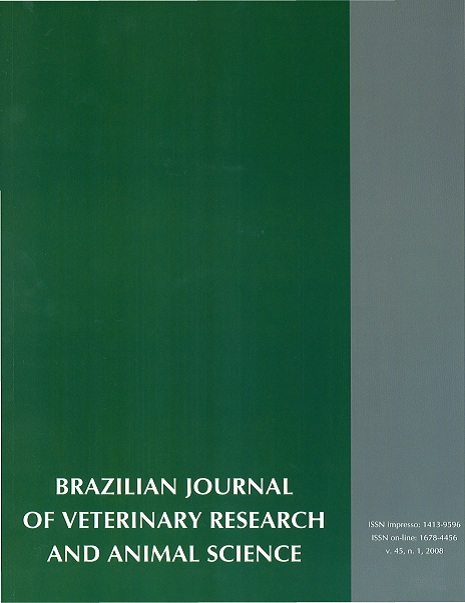Correlation between arterial pressure and blood flow in the external ophthalmic artery in cats (felis catus linnaeus, 1758)
DOI:
https://doi.org/10.11606/issn.1678-4456.bjvras.2008.26721Keywords:
Cats, Ophthalmology, Blood pressure, Rheology, Ophthalmic arteryAbstract
There were used 20 mixed breed cats, both male and female, with body mass between 2 and 4 kilograms, that received anesthesia with tiletamine and zolazepam (6,0 mg/kg). The femoral artery was assepticale cannulated and a manometer connected to an air column was connected to the catheter. The MAP was surveyed before and every 15 minutes until the end of the ultrasound examination. The flow of the external ophthalmic artery was measured through the ultrasond equipment, with an echo-doppler and a sectorial transducer of 6.0 MHz, directly applied to the cornea. Each eye had the artery flow surveyed by the equipment's own device, 3 samples being taken. The vascular resistance index was calculated based on the mean values of systolic and diastolic flow of each vasses. An average value for the MAP of 144.9 ± 26.68 mmHg and a flow of 14.28 ± 41.3 cm/sec for the external ophthalmic artery in the right eye in systole, 23.95 ± 11.46 cm/sec in diastole and 42.75 ± 12.64 cm/sec in the left eye in systole, 25.45 ± 9.61 cm/sec in diastole, were verified, there being no significant difference between the eyes. The calculated index of vascular resistance was of 0.4175 ± 0.0774 for the external ophthalmic artery in the right eye and 0,4015 ± 0.0719 for the left eye, without any significant difference between the eyes. The results point to an intrinsic mechanism of flow control, controlled by local factors in the external ophthalmic artery. The values of the resistance index denote a low flow artery. Concluding, this study revealed the reference values, above cited, for the MAP and the blood flow in the external ophthalmic artery in mixed breed cats, anesthetized with tiletamine and zolazepam, and the information that there is no correlation between these values.Downloads
Download data is not yet available.
Downloads
Published
2008-02-01
Issue
Section
UNDEFINIED
License
The journal content is authorized under the Creative Commons BY-NC-SA license (summary of the license: https://
How to Cite
1.
Gomçalves GF, Pippi NL, Leme MC, Custódio AT, Silva AV da, Romagnolli P, et al. Correlation between arterial pressure and blood flow in the external ophthalmic artery in cats (felis catus linnaeus, 1758). Braz. J. Vet. Res. Anim. Sci. [Internet]. 2008 Feb. 1 [cited 2024 Apr. 24];45(1):57-66. Available from: https://www.revistas.usp.br/bjvras/article/view/26721





